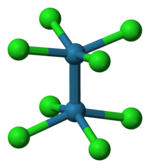Quadruple bond
A quadruple bond is a type of

History
The first crystallographic study of a compound with a quadruple bond was provided by Soviet chemists for salts of Re
2Cl2−
8.
2Cl4−
8.
Soon thereafter, F. Albert Cotton and C.B. Harris reported the crystal structure of potassium octachlorodirhenate or K2[Re2Cl8]·2H2O.[5] This structural analysis indicated that the previous characterization was mistaken. Cotton and Harris formulated a molecular orbital rationale for the bonding that explicitly indicated a quadruple bond.[3] The rhenium–rhenium bond length in this compound is only 224 pm. In molecular orbital theory, the bonding is described as σ2π4δ2 with one sigma bond, two pi bonds and one delta bond.
Structure and bonding


The [Re2Cl8]2− ion adopts an eclipsed conformation as shown at left. The delta bonding orbital is then formed by overlap of the d orbitals on each rhenium atom, which are perpendicular to the Re–Re axis and lie in between the Re–Cl bonds. The d orbitals directed along the Re–Cl bonds are stabilized by interaction with chlorine ligand orbitals and do not contribute to Re–Re bonding.[6] In contrast, the [Os2Cl8]2− ion with two more electrons (σ2π4δ2δ*2) has an Os–Os triple bond and a staggered geometry.[6]
Many other compounds with quadruple bonds between transition metal atoms have been described, often by Cotton and his coworkers. Isoelectronic with the dirhenium compound is the salt K4[Mo2Cl8] (potassium octachlorodimolybdate).[7] An example of a ditungsten compound with a quadruple bond is ditungsten tetra(hpp).
Quadruple bonds between atoms of
See also
References
- .
- ISBN 0-471-84997-9.
- ^ ISBN 0-19-855649-7.
- ^ Kuznetsov, V. G.; Koz'min, P. A. "The structure of (pyH)HReCl4" Zhurnal Strukturnoi Khimii 1963, 4, 55-62.
- .
- ^ ISBN 0-13-841891-8.
- ISBN 0935702482.
- .
- PMID 22354425.
Further reading
- Cotton, F. A.; Harris, C. B. (1965). "The Crystal and Molecular Structure of Dipotassium Octachlorodirhenate(III) Dihydrate, K2[Re2Cl8]·2H2O". .
